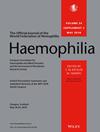Performance of instrumental activities of daily living in patients with haemophilic arthropathy. A cross-sectional cohort study
Abstract
Background
The development of haemophilic arthropathy causes joint damage that leads to functional impairment that limits the performance of activities in patients with haemophilia. The aim was to identify the best predictive model for performing instrumental activities of daily living in adult patients with haemophilia arthropathy.
Methods
Cross-sectional cohort study. 102 patients were recruited. The dependent variable was the performance of instrumental activities of daily living (Lawton and Brody scale). The dependence on the performance of activities of daily living was the dependent endpoint (Barthel scale). The secondary variables were joint damage (Hemophilia Joint Health Score), pain intensity, and clinical, anthropometric, and sociodemographic variables.
Results
The degree of dependence, joint damage, pain intensity, and marital status (Cp = 5.60) were the variables that best explain the variability in the performance of instrumental activities of daily living (R2adj = 0.51). Loss of predictive capacity is acceptable with good mean internal (R2 mean = 0.40) and external (R2-r2 = 0.09) validation. According to the predictive pattern obtained, patients with haemophilia, who were married, without joint pain or damage, and independent in their day-to-day lives, had a score of 7.91 points (95% CI: 7.42; 8.39) in the performance of instrumental activities of daily living.
Conclusions
The predictive model for the functional capacity of instrumental activities of daily living in haemophilia patients encompasses factors such as level of autonomy, joint impairment, pain severity, and marital status. Notably, despite the presence of joint damage, individuals with haemophilia exhibit a significant level of independence in carrying out both basic daily tasks and instrumental activities of daily living.
International registration number
Id NCT04715100.

 求助内容:
求助内容: 应助结果提醒方式:
应助结果提醒方式:


